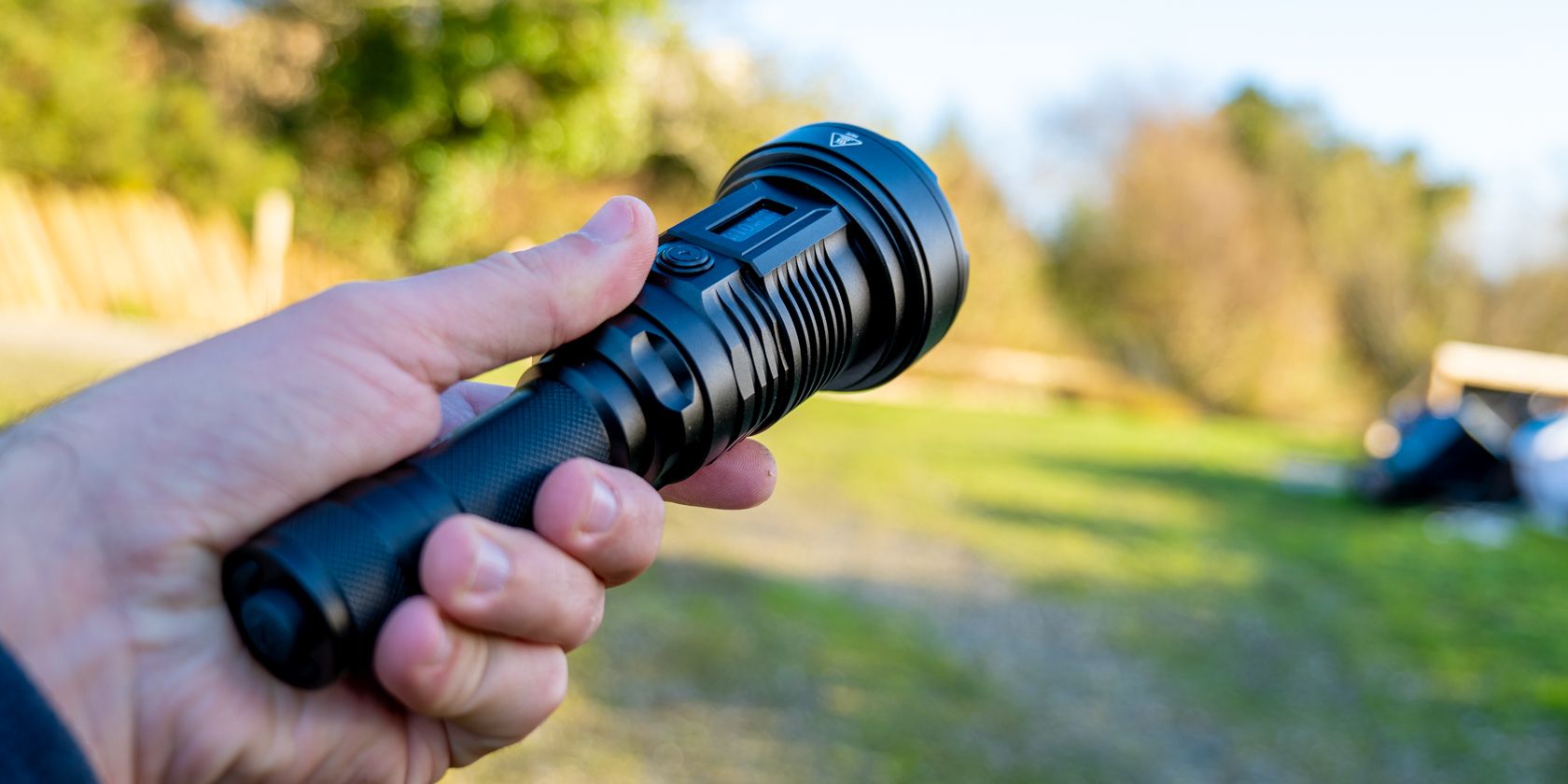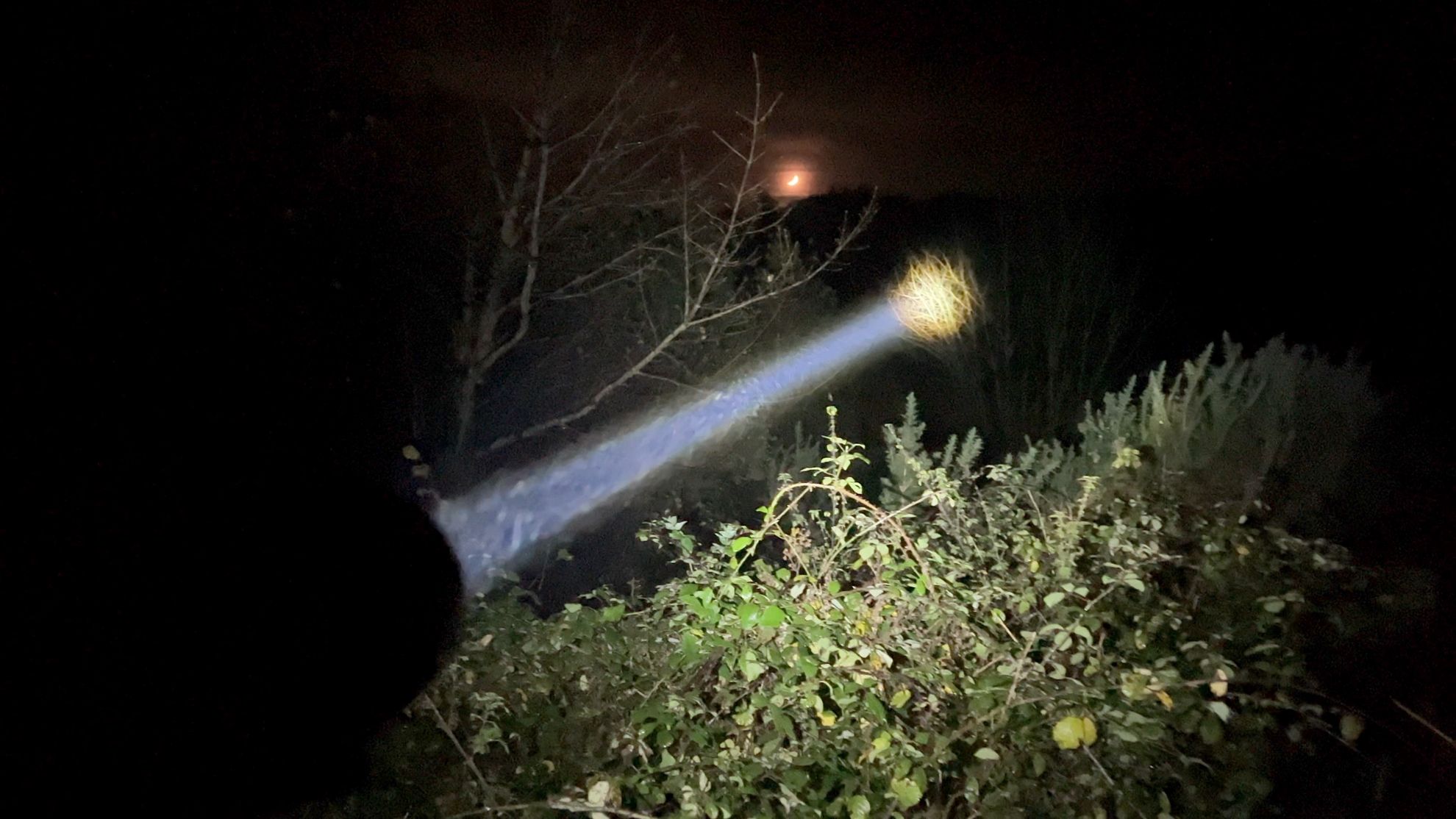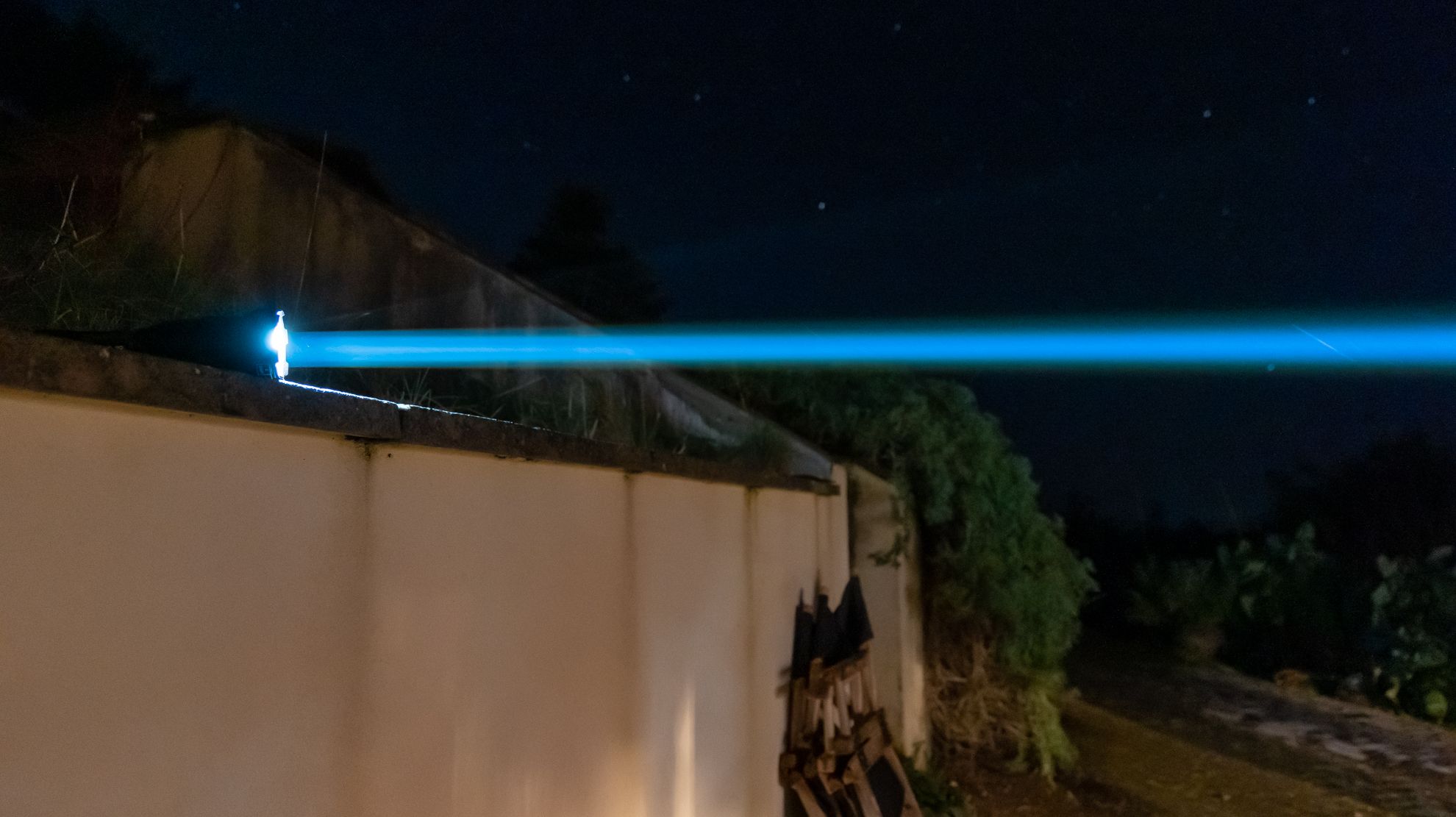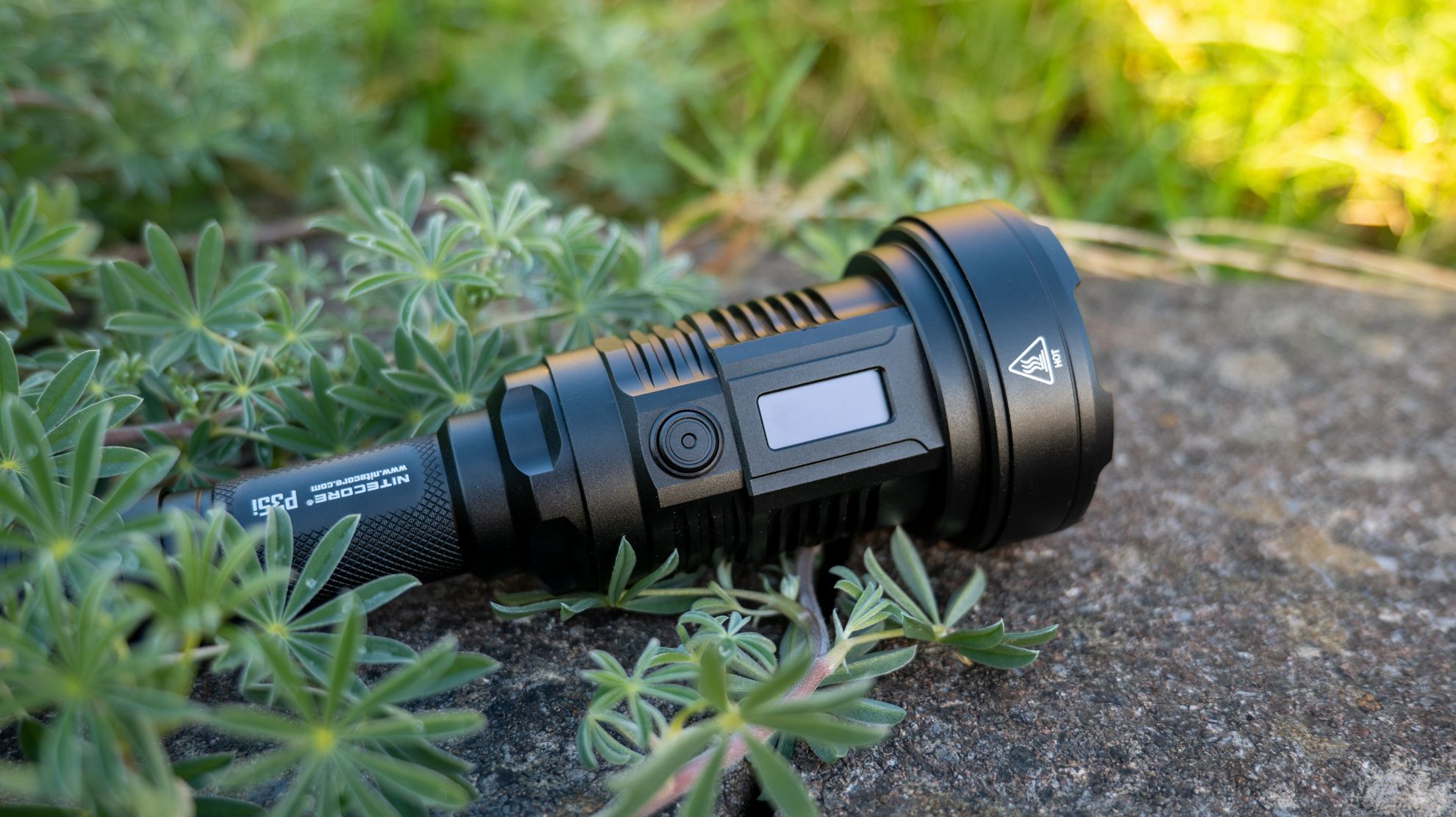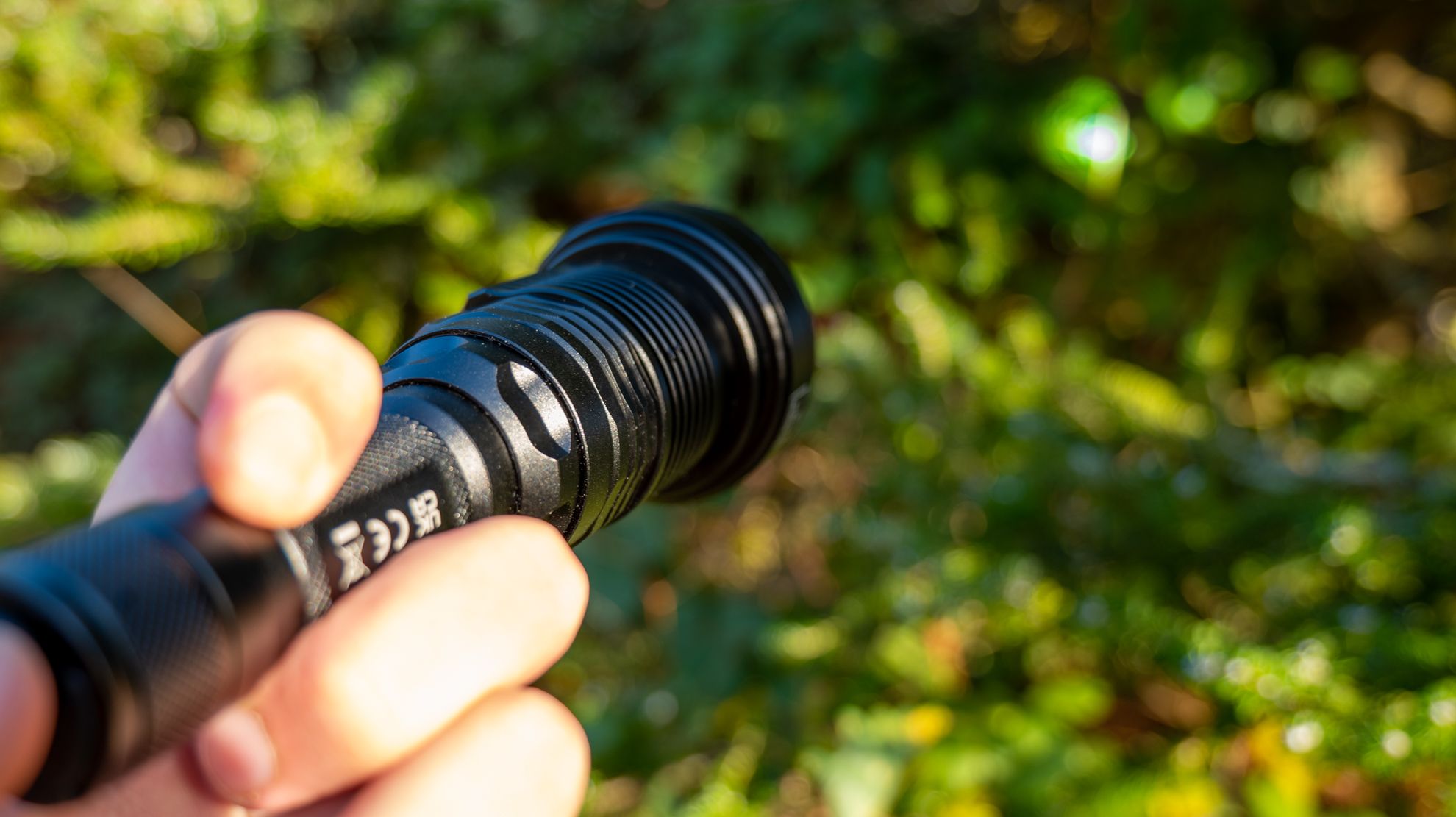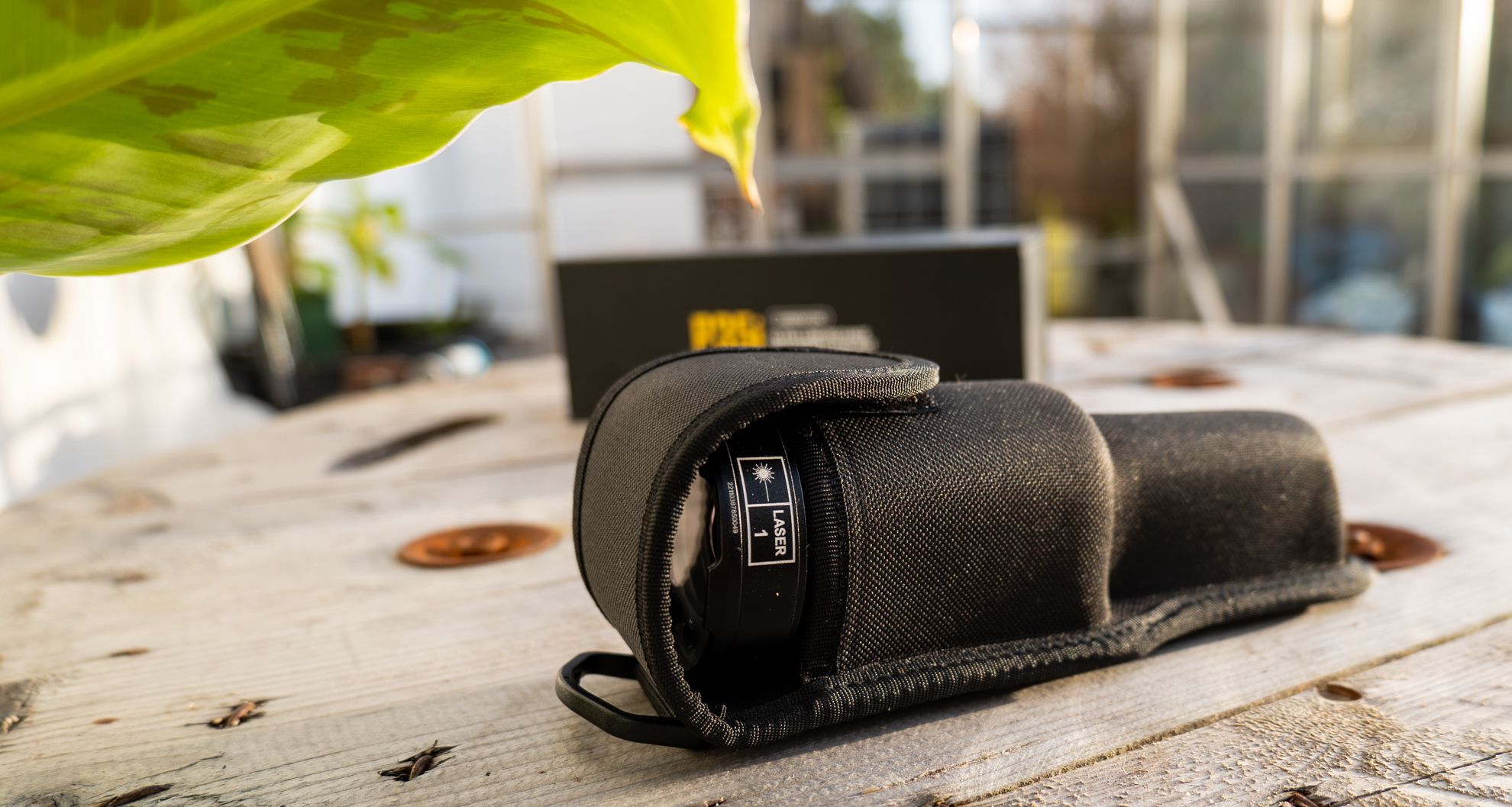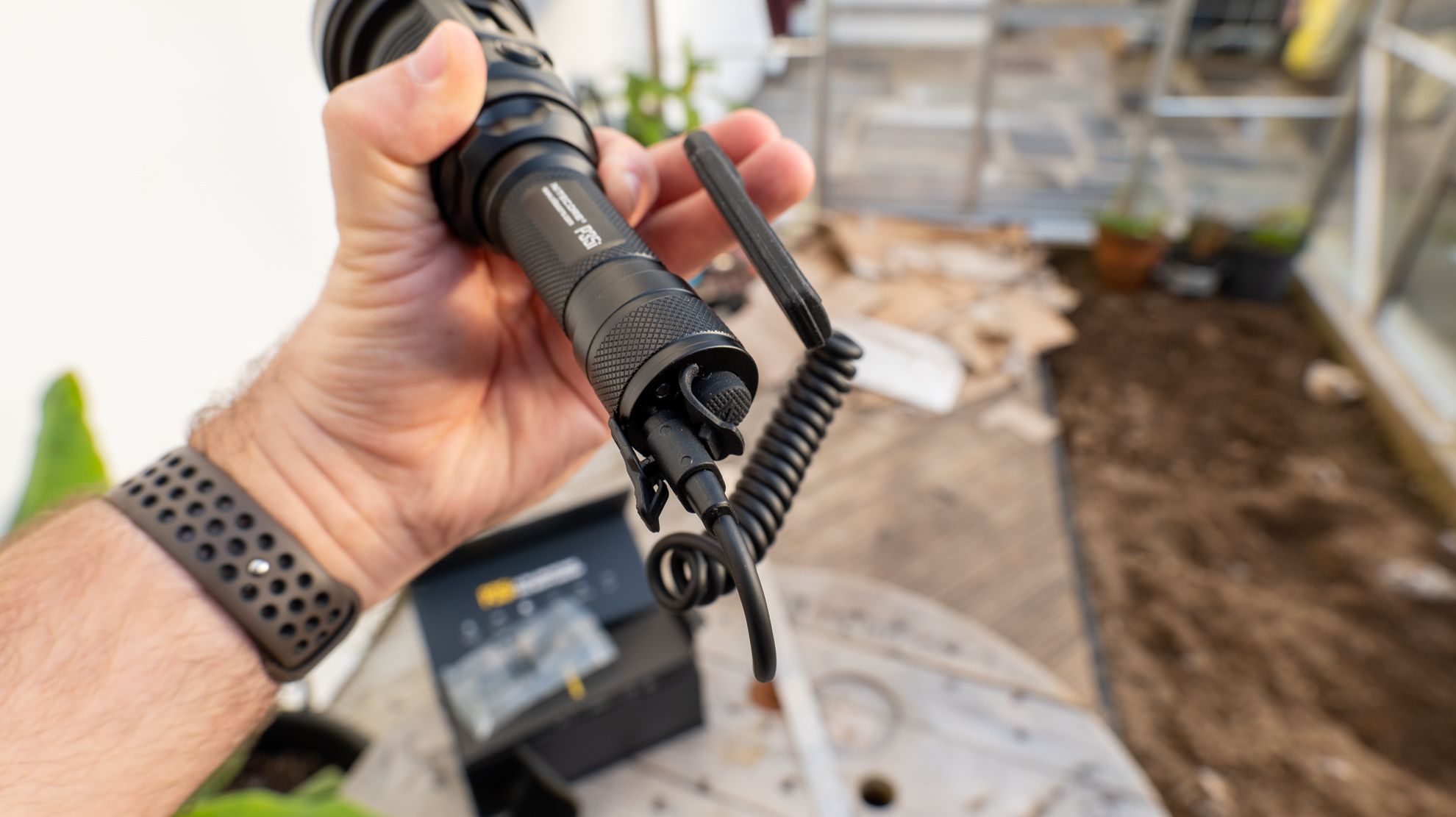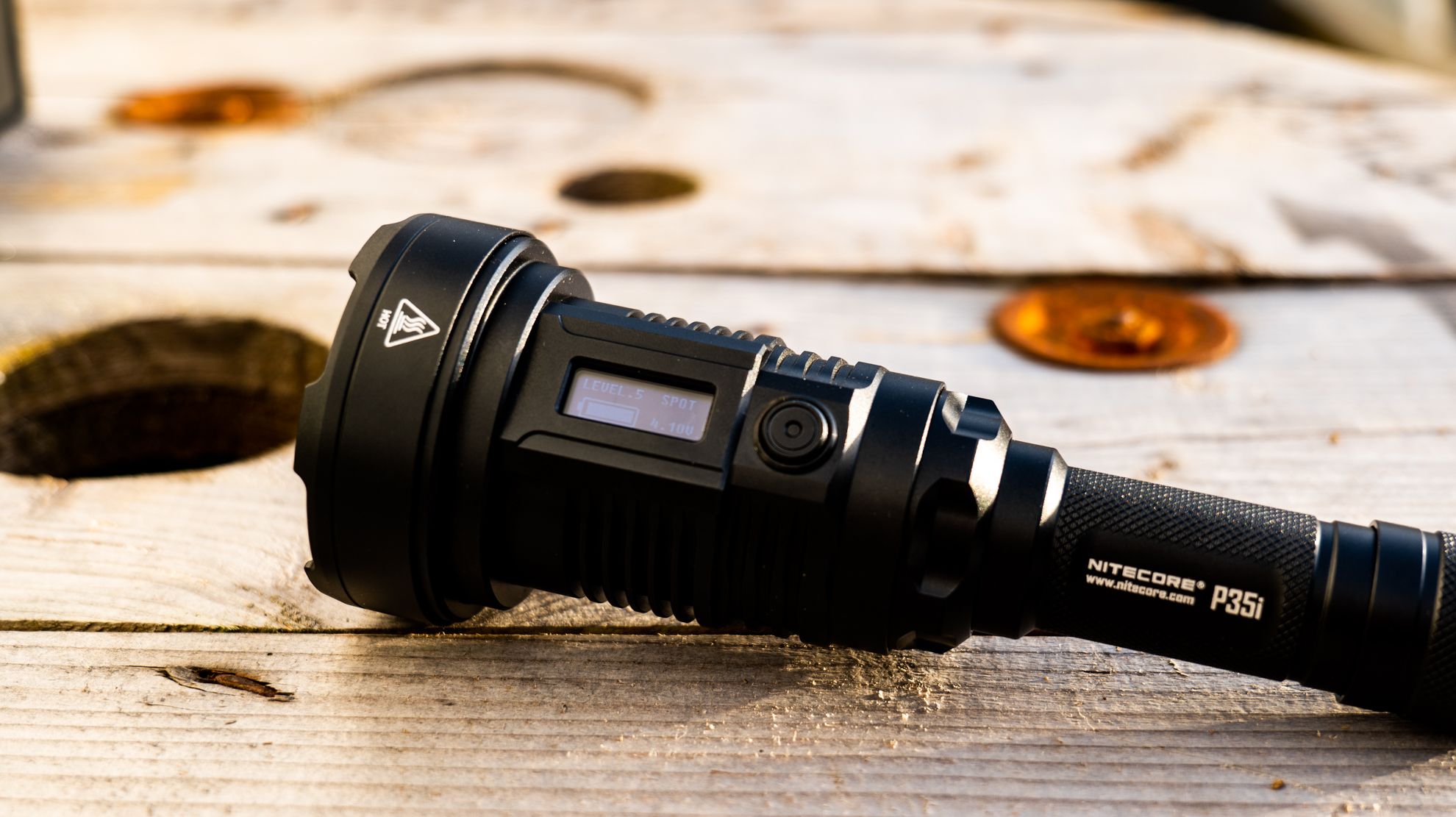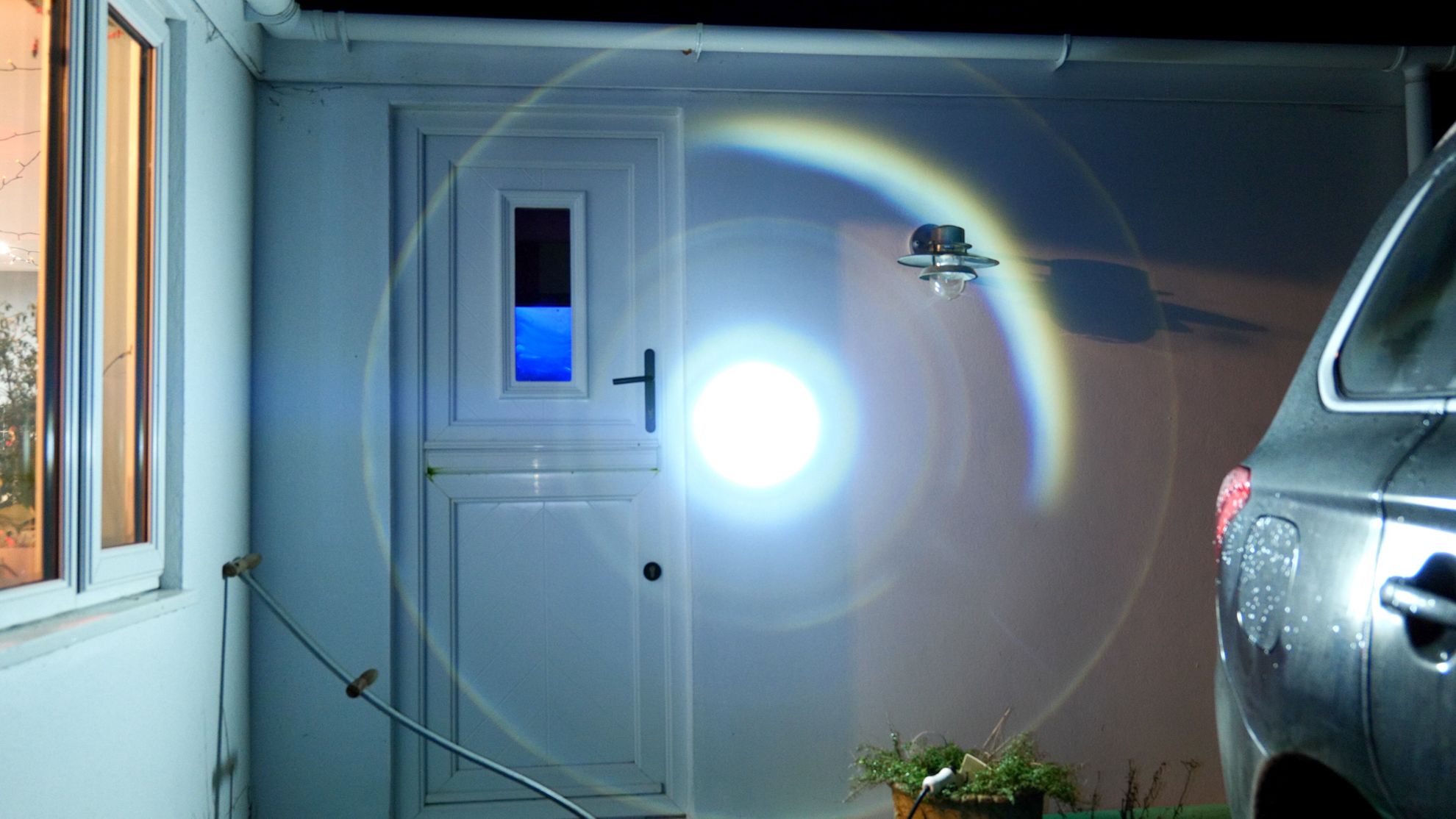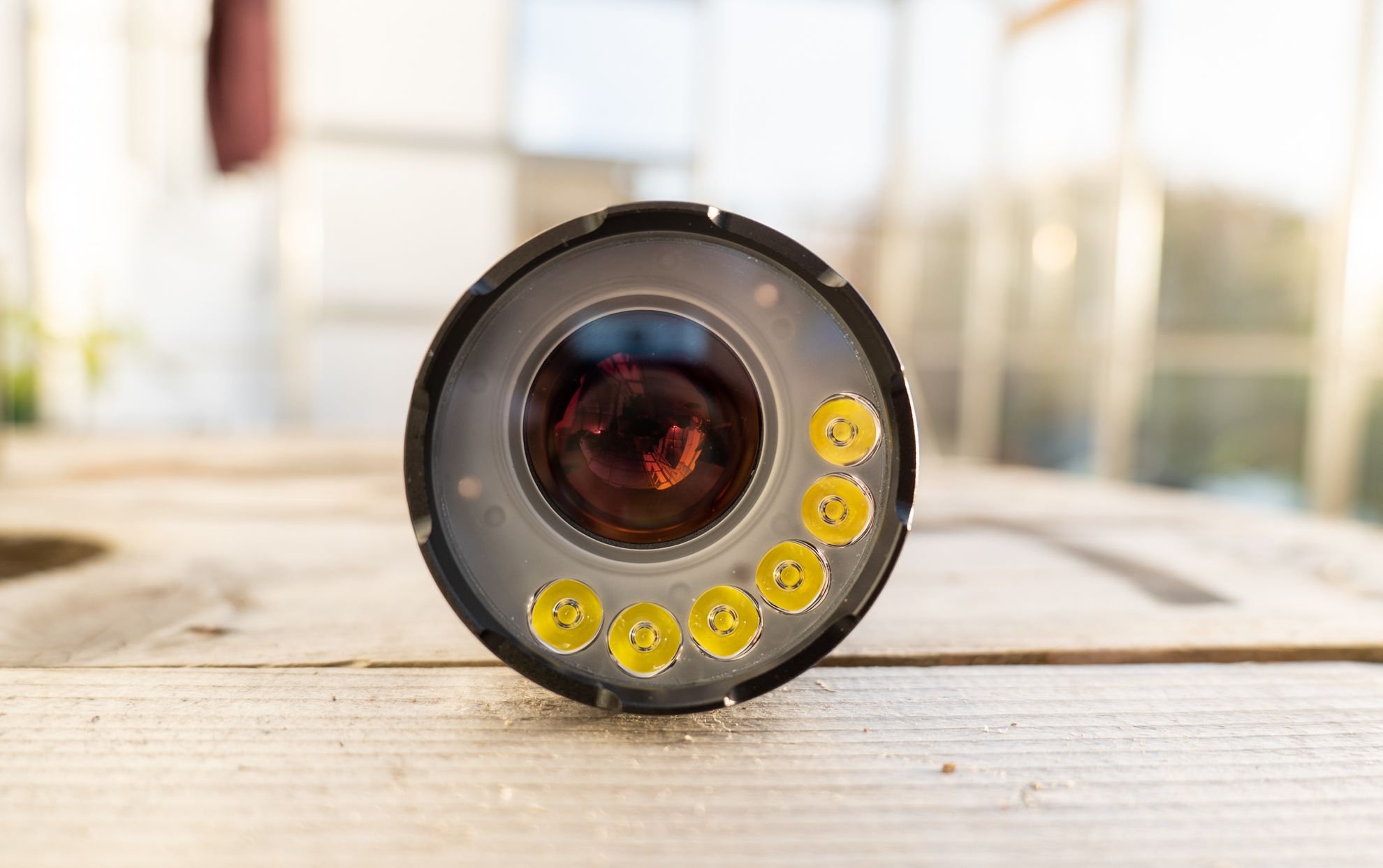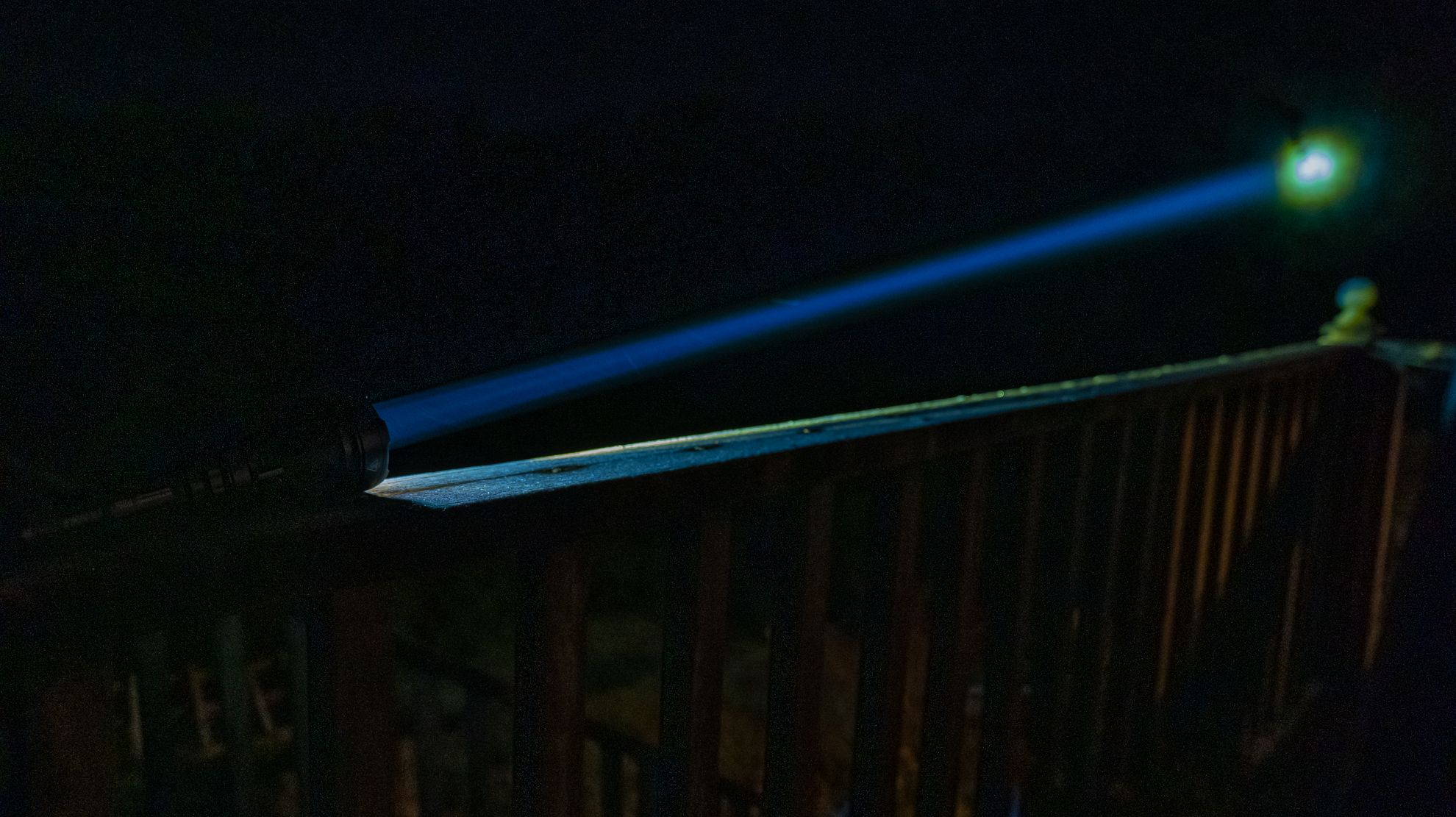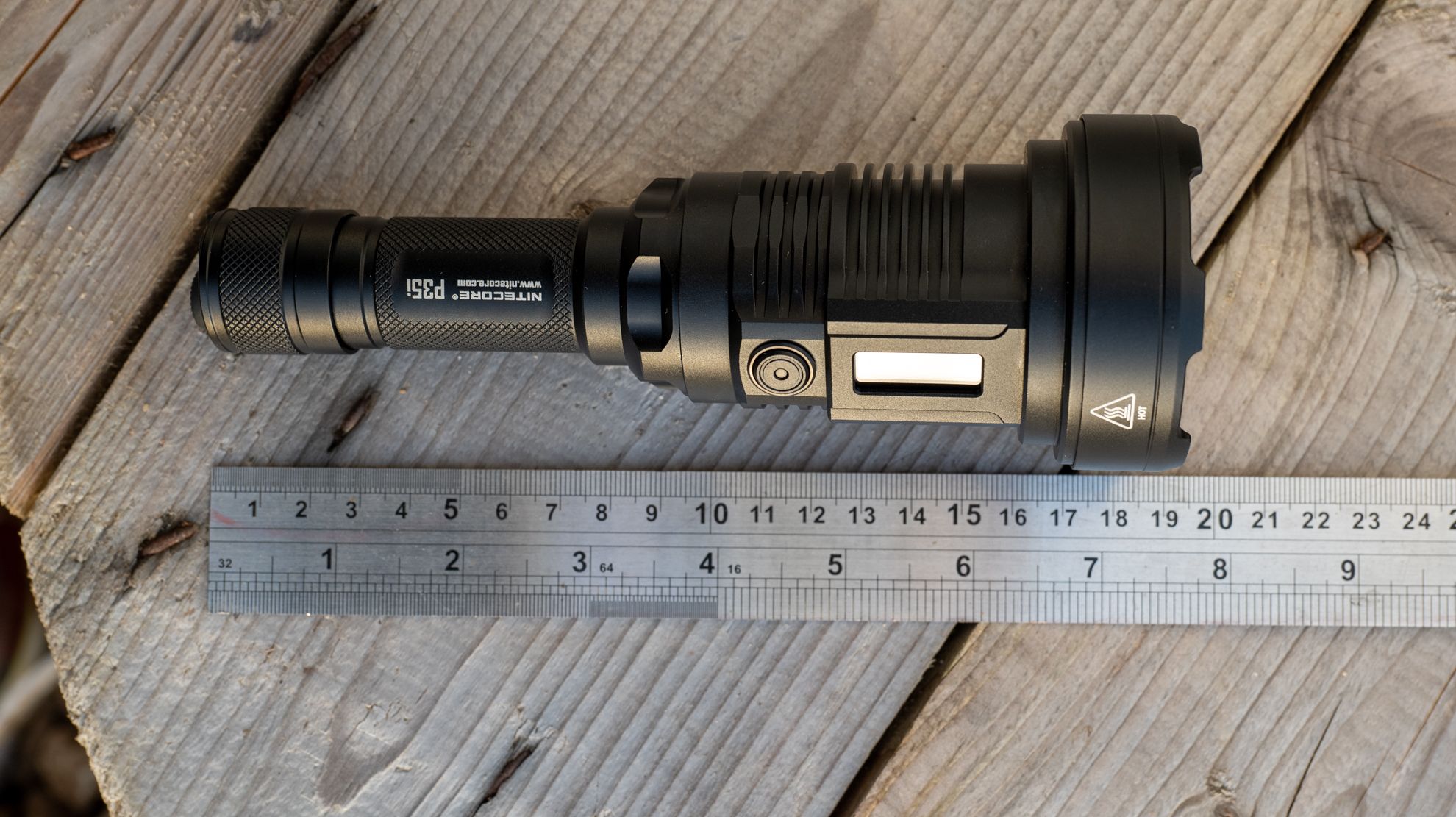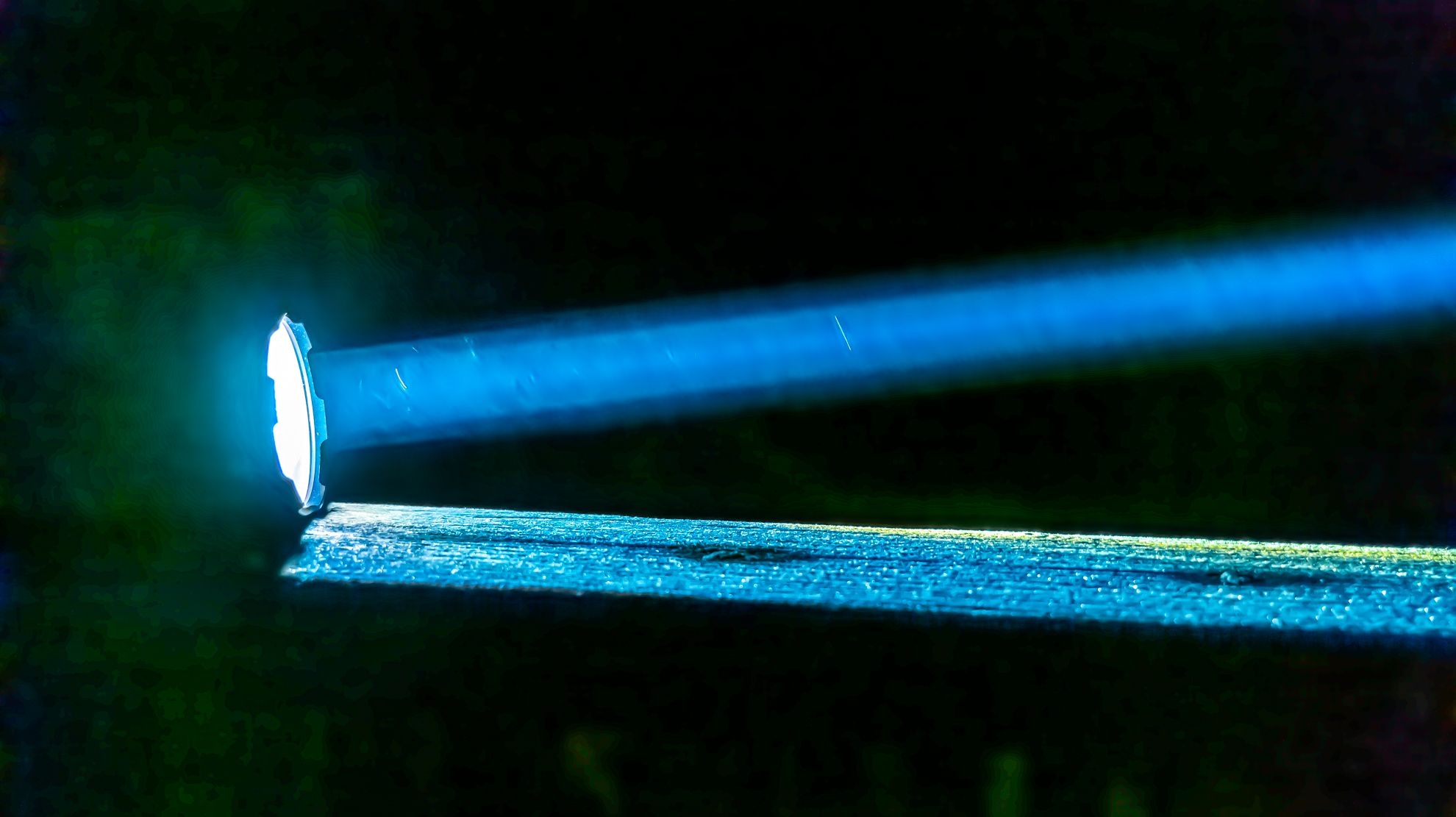Nitecore P35i
While Laser Excited Phosphor flashlights offer incredible Lightsaber-like output, they're also not that helpful in the real world as they don't provide context around the target. The Nitecore P35i solves the LEP problem by combining a traditional 3000-lumen LED floodlight with a 410-lumen LEP module. You opt to use either mode alone or mix both together at the same time.
While the headline numbers aren't nearly as impressive as some flashlights, the P35i is a versatile dual-function device that means if you only carry one flashlight, it should be this one.
- Brand: Nitecore
- Battery: Nitecore 21700 i-series, or 2 x CR123
- Dimensions: 7.36" long, 2.56" diameter at head
- Max beam distance: One mile / 1600m
- Max output: 3000 lumens (Mix), 410 lumens (LEP Spot)
- Max beam intensity: 500,000cd
- Weight: 10.46oz (300g)
- LEDs: Six Cree XP-G3
- Max runtime: 2 hours 15 minutes of LEP Spot High mode, or 45 minutes of Flood / Mix mode. 60 hours moonlight flood mode (10 lumens).
- Battery Capacity: 5000mAh
- Pretend you're a Jedi
- Mix mode output means the LEP is actually useful
- Choice of modes
- Light spill / halo in LEP mode
- The USB-C port cover is fiddly and opens too easily
The Nitecore P35i is the world's first combined LED flashlight and LEP. With a maximum beam range of one mile (or 1.6km), this unique dual-function flashlight can fulfill a wide range of uses with a pin-sharp single long-range beam, a traditional short-range flood light, or both at once. Is this the ultimate EDC? Maybe. At the very least, it solves the LEP problem.
What is an LEP Flashlight?
You're probably familiar with LEDs—or Light Emitting Diodes—which are highly efficient and bright light sources used in almost all electronics nowadays. But have you heard of LEP? It stands for Laser Excited Phosphor, and it's a bit like a mix of a laser pointer and LED.
Phosphor is typically used as a filter in combination with blue LEDs to get a white light source in traditional flashlights. The LED will emit blue light, which the phosphor absorbs, and changes into white. With an LEP, a blue laser is used instead, pointing at a phosphor crystal, which reemits a superbly bright white light.
But why bother? How is this new LEP technology superior to LEDs? The main reason to use an LEP is that the beam can be more easily focussed. This results in an extremely narrow beam with almost no light spillage—a bit like a real-life lightsaber.
The P35i's LEP module manages a maximum of 410 lumens, and while that might not sound like much compared to, say, the 80,000 lumens you can get from the AceBeam X75 (our review), the highly focussed beam means that the light can travel for a mile. A little light can indeed go a very long way.
However, the strength of LEPs is also their greatest weakness, because the beam can be too precise for real-world usage. Imagine a mountain rescue situation: it's all very well being able to fully illuminate a meter-squared area half a mile away and see it with crystal clarity—but without the contextual information of what's around it, you can't offer directions to the rescue crew to locate the target.
But the P35i combines both traditional high-brightness LEDs in a floodlight arrangement with an LEP module—giving you the choice of a highly focussed beam, a basic floodlight, or even a mix of both.
And a quick warning: this is Class 1 Laser Product. You can burn things with this. Turbo mode will get very hot very quickly, but only on the emitter side.
P35i Design
The P35i is certainly unique, with a space-age feel to it, especially if you're looking at it head-on. The emitter features a roughly inch off-center lens for the LEP module, surrounded by six Cree XP-G3 LEDs. Uniquely, these are all positioned in a crescent moon shape. In use, this doesn't seem to affect the output shape though, you still get an excellent, broad, floody output.
Just under the lens shroud is a small OLED screen and mode button. This handy feature provides immediate feedback on what mode and intensity is currently selected, even without turning on the light output.
The handgrip can be found on the far end of the P35i, with a knurled surface for extra grip. To me, the handheld area is ever so slightly too thin at 1-inch diameter and a little too short, so I would have preferred something a bit substantial to grab onto. It ends up feeling slightly front-heavy unless you push your grip forward slightly.
Overall the P35i is 7.36" long, and weighs 10.46 oz (or just under 300g) with the battery. The diameter at the head is 2.56".
On the end of the P35i is the main on/off switch, which can also function as a momentary tactical switch for whatever mode was last used. The button protrudes a fair bit, and I can see this being accidentally pressed if you keep it outside the holster.
You'll find a USB-C charging port next to the button, underneath a slightly annoying rubber cover, which never seems to close correctly and also opens far too easily. It's definitely an afterthought to get an IP rating; I wouldn't suggest getting this wet.
Included in the box is a tactical remote switch, and rather than having to replace the tail-end switch completely, instead, it plugs into the USB-C port and latches on. However, if you want to use this mounted on a rifle, you'd need to provide your own Picatinny adaptor. The tactical switch replicates both the mode and power button, and provides a way to strobe the P35i, which isn't possible out of the box.
Also included in the box is a 21700 "i Series" Nitecore battery, a CR123 battery adaptor, a holster, and spare o-rings.
The holster is very sturdy, and for safety reasons I'd encourage you to keep it in there when not in use, and not just in your pocket. There's no physical lockout or otherwise on the Nitecore P35i, so accidentally turning it on to high LEP mode in your pocket will result in a hole in your jeans, and perhaps your leg too.
P35i Operating Modes
As a dual-function flashlight, you have plenty of modes to choose from, starting from the three core modes: Flood, Spot, and Mix. When the P35i is off, hold down the mode button and click on the power to cycle through these. Switching modes will activate the respective light momentarily, so it's not something you can do discreetly.
Activating the P35i will return it to whatever the last mode used was—which you can check at any time the P35i is off by tapping the mode button. Once on, you can tap the mode button to cycle through the intensities for that particular mode. Both Spot and Flood have five levels to choose from.
If you're in Mix mode, you get three intensities to choose from instead. You can also go straight to Mix Turbo mode from either Spot or Flood by holding down the mode button.
At this point, it's worth mentioning that tiny OLED screen again. When off, you can press the button to indicate what the last mode is. But when the P35i is on, it's even more useful, with information about the expected runtime remaining, beam range (meters), and brightness (in lumens). When Turbo mode is activated, it instead switches to a countdown timer represented by a bar.
Like most of you, I assumed sticking an OLED screen onto a flashlight was a silly gimmick. But having now used it, I can really appreciate the utility. Just having an indication of time remaining is worth it, as is knowing what last mode is and whether you might blind someone by turning it on in your current situation.
Light Output
You get a very cold pure white light from both the LEDs and LEP module on the P35i. Taken purely as a floodlight, the total output is not nearly as impressive as other floodlights in this price range—but 3000 lumens isn't to be sniffed at either. It's the LEP spot mode that you're really buying this for, and I dont think you'll be disappointed. The first time I turned this on at night, I was truly blown away but how pin-sharp the beam was and how well it could illuminate something so far away on the other side of our valley.
On a technical level, there is a little light leakage from the LEP Spot mode—a slight halo and reflection from the LED lenses which are obvious if you aim it at something close. In actual usage at a distance, you won't notice it.
While Spot mode from the LEP is most impressive in photos and fun to test out, I suspect it's the Mix mode that will get the most usage by owners of the P35i. An overall flood to illuminate the area and provide context—combined with that pin-sharp spot focus—is unmatched by any other flashlight on the market right now.
In terms of runtime, the quoted totals for a full battery are:
Flood mode:
- Ultralow (10 lumens), 60 hours
- Low (70 lm), 28 hours.
- Medium (300 lm), 6 hours 45 minutes.
- High (1000 lm), 2 hours.
- Turbo (3000 lumens), 45 minutes.
Spot mode:
- Ultralow (25 lm), 12 hours.
- Low (65 lm), 8 hours.
- Medium (130 lm), 4 hours 30 minutes.
- High (200 lm), 3 hours.
- Turbo (410 lm), 2 hours 15 minutes
Mix mode:
- Low (130 lm), 6 hours.
- Medium (420 lm), 2 hours 45 minutes.
- High (3000 lm), 45 minutes.
Using a basic light meter, I measured light output on the highest Spot mode. At a distance of 10 meters, it hovered between 4500 and 5000 lux. Extrapolating this to candela (a measure of lux at 1m) gives us around 500,000cd (or 500kcd). To work out the throw distance, which is how far the beam will reach before the illuminance on a surface falls to 0.25 lux, we divide by 0.25 and find the square root. This gives a possible throw distance of 1414m, or around one mile. Nitecore claims 1650m, which is within the margin of error for my basic testing equipment.
By comparison, the throw distance of the AceBeam X75, which is a flood-type flashlight, is just less than the Nitecore P35i at around 1300 meters—despite the actual light output being far, far higher at 80,000 lumens, compared to the 410 lumens of the P35i. The X75 blasts that light out in a huge radius; the P35i focuses it on a single spot.
Note that in either case, this doesn’t mean you can meaningfully see anything at that distance; merely that’s it a standardized way of measuring throw with flashlights. This flashlight will throw the equivalent of moonlight at however many meters in one spot. For observers from a distance, the beam may appear to travel further. For those standing in the projected area, moonlight might not be enough to make use of.
Batteries and Charging
Interestingly, you'll find two options included in the box with the P35i. The first is the 21700-sized 5000mAh battery, a Nitecore NL2150HPi. This can be charged via the USB-C port that's built into the tail cap, and is the best way to power the P35i with the full selection modes open to you. This is not compatible with generic rechargeable 21700 batteries, so you'll want any extras or replacement directly from Nitecore.
The second option is to use the CR123 battery holder, which takes two CR123 batteries. But you should be aware that this will limit your output modes somewhat, excluding the Turbo and High intensity when in mix mode.
The Nitecore P35i is an LEP Flashlight That's Actually Useful
The design of the Nitecore P35i is peculiar and futuristic but has a few minor annoyances that stop me from awarding full marks. The handle feels too small for my hands, but mostly the USB-C port cover is terrible. The button protrudes too much, and I'm not convinced about this plug-in USB-C tactical switch.
In terms of actual light output, that's not perfect either: there's a slight halo on the LEP spot mode. But that's really just nitpicking because in actual practical use, I love this thing. The Mix mode is likely to get the most usage for me, but it's certainly fun to use the Spot mode, solely for pretending you're a Jedi. It's an ingenious design to mix both kinds of light outputs at once, giving you the best of both worlds, so you get both the contextual information from a small flood light, and that pin-sharp long-range spot.
Also, did I mention a five-year warranty? That's pretty awesome.
As both a general-use and long-range flashlight, the P35i hits all the right spots. It's not the brightest LEP flashlight around, nor is it the brightest flood in this price range. But if you're only going to carry one light, it should be this one. The only reason not to buy the P35i is that it's so good, I expect it'll be copied soon and improved upon even further.

